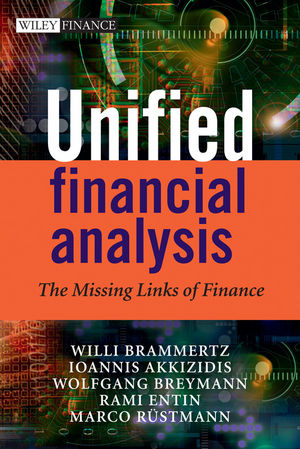
Unified Financial Analysis
John Wiley & Sons Ltd (Verlag)
978-0-470-69715-3 (ISBN)
- Titel ist leider vergriffen;
keine Neuauflage - Artikel merken
Unified Financial Analysis arrives at the right time, in the midst of the current financial crisis where the call for better and more efficient financial control cannot be overstated. The book argues that from a technical perspective, there is no need for more, but for better and more efficiently organized information. The title demonstrates that it is possible with a single but well organized set of information and algorithms to derive all types of financial analysis. This reaches far beyond classical risk and return or profitability management, spanning all risk categories, all valuation techniques (local GAAP, IFRS, full mark-to-market and so on) and static, historic and dynamic analysis, just to name the most important dimensions. The dedication of a complete section to dynamic analysis, which is based on a going concern view, is unique, contrasting with the static, liquidation-based view prevalent today in banks. The commonly applied arbitrage-free paradigm, which is too narrow, is expanded to real world market models.
The title starts with a brief history of the evolution of financial analysis to create the current industry structure, with the organisation of many banks following a strict silo structure, and finishes with suggestions for the way forward from the current financial turmoil. Throughout the book, the authors advocate the adoption of a 'unified financial language' that could also be the basis for a new regulatory approach. They argue that such a language is indispensable, if the next regulatory wave - which is surely to come - should not end in an expensive regulatory chaos. Unified Financial Analysis will be of value to CEOs and CFOs in banking and insurance, risk and asset and liability managers, regulators and compliance officers, students of Finance or Economics, or anyone with a stake in the finance industry.
Willi Brammertz (Zurich, Switzerland) has worked for 20 years in the field of financial analysis. He is founding partner of IRIS, now part of FRS Global, and father of one of the world's leading financial analysis systems riskpro(TM). This system now runs in more than 200 banks in about 20 countries. Ioannis Akkizidis (Zurich, Switzerland) is Financial Risk Management Consultant and Analyst for IRI S integrated risk management. Wolfgang Breymann (Zurich, Switzerland) is Professor for Financial Mathematics at the Zurich University of Applied Science Winterthur. Ram Entin (Zurich, Switzerland) is Financial Risk Management Consultant and Analyst for IRIS integrated risk management. Marco Rustmann (Zurich, Switzerland) is a Lecturer and Researcher at the Zurich University of Applied Sciences in Risk and Insurance Management He holds a PhD from the University of St Gallen
List of Figures. List of Tables. Acknowledgments. Preface. PART I: INTRODUCTION. 1. The Evolution of Financial Analysis. 1.1 Bookkeeping. 1.2 Modern finance. 1.3 Departments, silos and analysis. 1.4 The IT system landscape. 1.5 New approach. 1.6 Hazards of a single solution. 2. Finding the Elements. 2.1 The notion of elements. 2.2 Elements of financial analysis. 2.3 Input elements. 2.4 Financial events and expected cash flows. 2.5 Risk factors and risk categories. 2.6 The time dimension. 2.7 Classification of analysis. 2.8 Nonfinancial cash flows. 2.9 The methodology as an image. PART II: INPUT ELEMENTS. 3. Financial Contracts. 3.1 Modeling of financial contracts. 3.2 Standard contract types. 3.3 Rules and mechanisms of standard contracts. 3.4 Examples. 3.5 Nonstandard contract types. Appendix: Practical considerations. 3.A.1 Mapping process. 3.A.2 Data quality. 4. Market Risk Factors. 4.1 Expectations. 4.2 Static modelling. 4.3 Stochastic market models: the arbitrage-free world. 4.4 Stochastic market models: the real world. 4.5 Alternative valuation techniques. Further reading. 5. Counterparty. 5.1 Exposure, rating and probabilities of default. 5.2 Data determining gross exposure. 5.3 Credit enhancements. 5.4 Credit line and limits. 5.5 Credit ratings. Further reading 134. 6. Behavior. 6.1 Risk sources and behavior. 6.2 Market-related behavior. 6.3 Insurance-related behavior. 6.4 Credit risk-related behavior. 6.5 Sequence of behavioral effects. Further reading. 7. Costs. 7.1 Introduction to cost accounting. 7.2 Allocating costs to financial contracts. 7.3 Integration of costs into the general framework. 7.4 Summary and conclusions. Further reading. PART III: ANALYSIS - LIQUIDATION VIEW. 8. Financial Events and Liquidity . 8.1 Financial event processing. 8.2 Examples. 8.3 Behavioral events. 8.4 Liquidity reports. Further reading. 9. Value, Income and FTP. 9.1 Valuation principles. 9.2 The big four. 9.3 Other valuation principles. 9.4 Special cases. 9.5 IFRS 32, 39. 9.6 Funds transfer pricing. Further reading. 10. Sensitivity. 10.1 Challenges of sensitivity calculation. 10.2 Interest rate sensitivities from events. 10.3 Other market sensitivities. 10.4 Behavioral sensitivities. 10.5 Sensitivity reports. 11. Risk. 11.1 Risk and VaR. 11.2 Analytical VaR methods. 11.3 Numerical VaR methods. 11.4 Expected shortfall. 11.5 Stress and shock scenarios. 11.6 Regulatory risk measures. 11.7 Backtesting. Appendix: Historization. 11.A.1 Granularity. 11.A.2 Data reduction. 11.A.3 Intraday and parallel histories. Further reading. 12. Operational Risk. 12.1 Basic indicator and standardized approach. 12.2 Statistical basis of the advanced measurement approach. 12.3 Operational value at risk. Further reading. PART IV: ANALYSIS - GOING-CONCERN VIEW. 13. General Mechanisms. 13.1 Market conditions and general risk factors. 13.2 New financial production. 13.3 Behavior and counterparty. 13.4 Cost. 13.5 Balancing. Appendix: Aggregation. 13.A.1 Single contract level and performance. 13.A.2 Contract aggregation. 14. Banks. 14.1 Chart of accounts and portfolio structures. 14.2 Forecasting volume and characteristics. 14.3 Adding market forecast, counterparty information and behavior. 14.4 Analysis elements. 15. Life Insurance. 15.1 Chart of account. 15.2 The life contract. 15.3 Forecasting new production. 15.4 Analysis elements. 16. Non-life Insurance. 16.1 Chart of account. 16.2 The non-life contract. 16.3 The reinsurance contract. 16.4 Forecasting new volume and characteristics. 16.5 Analysis elements. 17. Nonfinancials. 17.1 Financial and nonfinancial corporates. 17.2 The nonfinancial model. 17.3 Analysis elements. 17.4 Corporate valuation. PART V: OUTLOOK AND CONCLUSIONS. 18. The Financial Laboratory. 18.1 Risk and performance measurements. 18.2 Example of an economic risk report. 18.3 Optimization. 18.4 Consistency. 19. Towards a Unified Financial Language. 19.1 The need for a unified financial language. 19.2 Structure of a unified financial language. 19.3 New finance, new regulation. Index.
| Erscheint lt. Verlag | 6.3.2009 |
|---|---|
| Reihe/Serie | Wiley Finance |
| Verlagsort | Chichester |
| Sprache | englisch |
| Maße | 178 x 252 mm |
| Gewicht | 936 g |
| Themenwelt | Wirtschaft ► Betriebswirtschaft / Management ► Finanzierung |
| ISBN-10 | 0-470-69715-6 / 0470697156 |
| ISBN-13 | 978-0-470-69715-3 / 9780470697153 |
| Zustand | Neuware |
| Haben Sie eine Frage zum Produkt? |
aus dem Bereich


